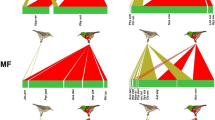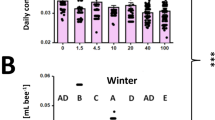Abstract
Male reproductive investment may signify a considerable cost to male insects that produce sperm packages or spermatophores. Male butterflies allocate much of their active time budget to mate location, and they may adopt different behavioural strategies to do so. In the speckled wood butterfly (Pararge aegeria L.), males adopt either a territorial wait-and-fight strategy (territorial perching) or a fly-and-search strategy in wider areas (patrolling). In this study, we analysed the impact of male age, male size and male behaviour (i.e. behavioural strategies and levels of activity) on spermatophore investment (i.e. spermatophore mass, number of eupyrene sperm bundles). As predicted, reproductive investment increased with male age and size. Nevertheless, the increase of spermatophore mass with age and the number of eupyrene sperm bundles (i.e. fertile sperm) was stronger in low-activity males compared to active flying males. This suggests that flight activity has a negative impact on male reproductive investment. However, males that were forced to fly in the laboratory produced more eupyrene sperm bundles than resting males. We discuss the potential effects of male–male competition and predation risk on current versus future male reproduction. Males adopting different mate-locating strategies (perching and patrolling) in outdoor cages did not differ in spermatophore traits as was predicted from their very different flight performances. Copulations of territorial perching males took somewhat longer than copulations with non-perching males. There was a significant family effect of spermatophore size and of the expression of male mate-locating strategies suggesting heritable variation. Female traits (i.e. age and size) did not strongly affect spermatophore production. We discuss the results relative to both ultimate and proximate explanations of the complex relationships between butterfly activity, behavioural strategies, age and spermatophore production.


Similar content being viewed by others
References
Andersson M, Iwasa Y (1996) Sexual selection. Trends Ecol Evol 11:53–58
Berwaerts K, Aerts P, Van Dyck H (2006) On the sex-specific mechanisms of butterfly flight: flight performance relative to flight morphology, wing kinematics, and sex in Pararge aegeria. Biol J Linn Soc 89:675–687
Berwaerts K, Matthysen E, Van Dyck H (2008) Take-off flight performance in the butterfly Pararge aegeria relative to sex and morphology: a quantitative genetic assessment. Evolution 62:2525–2533
Bissoondath CJ, Wiklund C (1995) Protein content of spermatophores in relation to monandry polyandry in butterflies. Behav Ecol Sociobiol 37:365–371
Bissoondath CJ, Wiklund C (1996) Effect of male mating history and body size on ejaculate size and quality in two polyandrous butterflies, Pieris napi and Pieris rapae (Lepidoptera: Pieridae). Funct Ecol 10:457–464
Boggs CL (1981) Selection pressures affecting male nutrient investment at mating in Heliconiine butterflies. Evolution 35:931–940
Boggs CL (2003) Environmental variation, life histories, and allocation. In: Boggs CL, Watt WB, Ehrlich PR (eds) Butterflies: ecology and evolution taking flight. University of Chicago Press, Chicago, pp 185–206
Bonduriansky R (2001) The evolution of male mate choice in insects: a synthesis of ideas and evidence. Biol Rev 76:305–339
Burnham KP, Anderson DR (2002) Model selection and multimodel inference. A practical information-theoretic approach, 2nd edn. Springer, New York
Candy DJ, Becker A, Wegener G (1997) Coordination and integration of metabolism in insect flight. Comp Biochem Phys B 117:497–512
Chown S, Nicolson SW (2004) Insect physiological ecology. Oxford University Press, Oxford
Cook PA, Wedell N (1996) Ejaculate dynamics in butterflies: a strategy for maximizing fertilization success? Proc R Soc Lond B 263:1047–1051
Delisle J, Bouchard A (1995) Male larval nutrition in Choristoneura rosaceana (Lepidoptera: Tortricidae): an important factor in reproductive success. Oecologia 104:508–517
Dewsbury DA (1982) Ejaculate cost and male choice. Am Nat 119:601–610
Dudley R (2000) The biomechanics of insect flight: form, function, evolution. Princeton University Press, Princeton
Erhardt A, Mevi-Schütz J (2009) Adult food resources in butterflies. In: Settele J, Shreeve T, Konvicka M, Van Dyck H (eds) Ecology of butterflies in Europe. Cambridge University Press, Cambridge, pp 9–16
Forsberg J (1987) A model for male mate discrimination in butterflies. Oikos 49:46–54
Gage MJG (1991) Risk of sperm competition directly affects ejaculate size in the Mediterranean fruit fly. Anim Behav 42:1036–1037
Gage MJG (1994) Associations between body size, mating pattern, testis size and sperm lengths across butterflies. Proc R Soc Lond B 258:247–254
Gage MJG, Baker RR (1991) Ejaculate size varies with socio-sexual situation in an insect. Ecol Entomol 16:331–337
Gage AR, Barnard CJ (1996) Male crickets increase sperm number in relation to competition and female size. Behav Ecol Sociobiol 38:349–353
Gibbs M, Breuker CJ, Van Dyck H (2010) Flight during oviposition reduces maternal egg provisioning and influences offspring development in Pararge aegeria (L.). Physiol Entomol 35:29–39
Gotthard K, Nylin S, Wiklund C (1999) Mating system evolution in response to search costs in the speckled wood butterfly, Pararge aegeria. Behav Ecol Sociobiol 45:424–429
Gurdon GB (1991) Nuclear transplantation in Xenopus. In: Kray B, Peng B (eds) Methods in cell biology, vol 36. Academic, London, pp 299–306
Jervis MA, Boggs CL, Ferns PN (2005) Egg maturation strategy and its associated trade-offs: a synthesis focusing on Lepidoptera. Ecol Entomol 30:359–375
Johnson LK, Hubbell SP (1984) Male choice: experimental demonstration in a brentid weevil. Behav Ecol Sociobiol 15:183–188
Karlsson B (1994) Feeding habits and change of body composition with age in three nymphalid butterfly species. Oikos 69:224–230
Kemp DJ, Wiklund C (2001) Fighting without weaponry: a review of male–male contest competition in butterflies. Behav Ecol Sociobiol 49:429–442
Kemp DJ, Wiklund C, Van Dyck H (2006) Contest behavior in the speckled wood butterfly (Pararge aegeria): seasonal phenotypic plasticity and the functional significance of flight performance. Behav Ecol Sociobiol 59:403–411
LaChance LE, Richard RD, Ruud R (1977) Movement of eupyrene sperm bundles from the testis and storage in the ductus ejaculatoris duplex of the male pink bollworm: effects of age, strain, irradiation, and light. Ann Entomol Soc Am 70:647–651
Lauwers K, Van Dyck H (2006) The cost of mating with a non-virgin male in a monandrous butterfly: experimental evidence from the speckled wood, Pararge aegeria. Behav Ecol Sociobiol 60:69–76
Leimar O, Norberg U, Wiklund C (2003) Habitat preference and habitat exploration in two species of satyrine butterflies. Ecography 26:474–480
Marden JH (2000) Variability in the size, composition, and function of insect flight muscles. Annu Rev Physiol 62:157–178
Marshall LD (1982) Male nutrient investment in the Lepidoptera: what nutrients should males invest? Am Nat 120:273–279
Marshall LD, McNeil JN (1989) Spermatophore mass as an estimate of male nutrient investment: a closer look in Pseudaletia unipuncta (Haworth) (Lepidoptera: Noctuidae). Funct Ecol 3:605–612
Merckx T, Van Dyck H, Karlsson B, Leimar O (2003) The evolution of movements and behaviour at boundaries in different landscapes: a common arena experiment with butterflies. Proc R Soc Lond B 270:1815–1821
Oberhauser KS (1988) Male monarch butterfly spermatophore mass and mating strategies. Anim Behav 36:1384–1388
Oberhauser KS (1989) Effects of spermatophores on male and female monarch butterfly reproductive success. Behav Ecol Sociobiol 25:237–246
Parker GA (1970) Sperm competition and its evolutionary consequences in the insects. Biol Rev 45:525–567
Parker GA (1984) Sperm competition and the evolution of animal mating strategies. In: Smith RL (ed) Sperm competition and the evolution of animal mating systems. Academic, New York, pp 1–60
Proshold FI (1996) Reproductive capacity of laboratory-reared Gypsy moths (Lepidoptera: Lymantriidae): effect of age of female at time of mating. J Econ Entomol 89:337–342
Rutowski RL (1991) The evolution of male mate-locating behavior in butterflies. Am Nat 138:1121–1139
Rutowski RL, Newton M, Schaeffer J (1983) Interspecific variation in the size of the nutrient investment made by male butterflies during copulation. Evolution 37:708–713
Rutowski RL, Gilchrist GW, Terkanian B (1987) Female butterflies mated with recently mated males show reduced reproductive output. Behav Ecol Sociobiol 20:319–322
Scott JA (1974) Mate-locating behavior of butterflies. Am Midl Nat 91:103–117
Shreeve TG (1984) Habitat selection, mate-location, and microclimatic constraints on the activity of the speckled wood butterfly Pararge aegeria. Oikos 42:371–377
Shreeve TG (1986) The effect of weather on the life cycle of the speckled wood butterfly Pararge aegeria. Ecol Entomol 11:325–332
Shreeve TG (1987) The mate location behaviour of the male speckled wood butterfly, Pararge aegeria, and the effect of phenotypic differences in hind-wing spotting. Anim Behav 35:682–690
Shreeve TG (1992) Adult behaviour. In: Dennis RLH (ed) The ecology of butterflies in Britain. Oxford University Press, Oxford, pp 22–45
Simmons LW, Craig M, Llorens T, Schinzig M, Hosken D (1993) Bushcricket spermatophores vary in accord with sperm competition and parental investment theory. Proc R Soc Lond B 251:183–186
Svärd L (1985) Paternal investment in a monandrous butterfly, Pararge aegeria. Oikos 45:66–70
Svärd L, Wiklund C (1986) Different ejaculate delivery strategies in first versus subsequent matings in the swallowtail butterfly Papilio machaon L. Behav Ecol Sociobiol 18:325–330
Trivers RL (1972) Parental investment and sexual selection. In: Campbell B (ed) Sexual selection and the descent of man 1871–1971. Aldine, Chicago, pp 136–179
Van Dyck H (2003) Mate location, a matter of design? Adaptive morphological variation in the speckled wood butterfly. In: Boggs CL, Watt WB, Ehrlich PR (eds) Butterflies: ecology and evolution taking flight. University of Chicago Press, Chicago, pp 353–366
Van Dyck H, Matthysen E (1998) Thermoregulatory differences between phenotypes in the speckled wood butterfly: hot perchers and cold patrollers? Oecologia 114:326–334
Van Dyck H, Matthysen E, Dhondt AA (1997a) The effect of wing colour on male behavioural strategies in the speckled wood butterfly. Anim Behav 53:39–51
Van Dyck H, Matthysen E, Dhondt AA (1997b) Mate-locating strategies are related to relative body length and wing colour in the speckled wood butterfly Pararge aegeria. Ecol Entomol 22:116–120
Van Dyck H, Matthysen E, Wiklund C (1998) Phenotypic variation in adult morphology and pupal colour within and among families of the speckled wood butterfly Pararge aegeria. Ecol Entomol 23:465–472
Vande Velde L, Turlure C, Van Dyck H (2011a) Body temperature and territory selection by males of the speckled wood butterfly (Pararge aegeria): what makes a forest sunlit patch a rendezvous site? Ecol Entomol 36:161–169
Vande Velde L, Damiens D, Van Dyck H (2011b) Spermatophore and sperm allocation in males of the monandrous butterfly Pararge aegeria: the female’s perspective. Ethology 117:645–654
Wickman PO (1992) Sexual selection and butterfly design: a comparative study. Evolution 46:1525–1536
Wickman PO, Karlsson B (1989) Abdomen size, body size and the reproductive effort of insects. Oikos 56:209–214
Wickman PO, Wiklund C (1983) Territorial defence and its seasonal decline in the speckled wood butterfly (Pararge aegeria). Anim Behav 31:1206–1216
Wiklund C, Persson A, Wickman PO (1983) Larval aestivation and direct development as alternative strategies in the speckled wood butterfly Pararge aegeria in Sweden. Ecol Entomol 8:233–238
Wiklund C, Kaitala A, Lindfors V, Abenius J (1993) Polyandry and its effect on female reproduction in the green-veined white butterfly (Pieris napi L). Behav Ecol Sociobiol 33:25–33
Acknowledgements
Thanks are due to Hubert Baltus and Melanie Gibbs for practical assistance and to Eric Le Boulengé and Gilles San Martin for statistical assistance. Thanks are also due to the editor and three anonymous referees for their valuable comments to improve our manuscript and to Ellyn Bitume for language editing. L.V.V. has a PhD grant of the FRIA-Fund of the Walloon government (FRS–FNRS, Belgium). This is publication no. BRC 236 of the Biodiversity Research Centre (UCL).
Author information
Authors and Affiliations
Corresponding author
Additional information
Communicated by D. Kemp
Rights and permissions
About this article
Cite this article
Vande Velde, L., Silvestre, P., Damiens, D. et al. Male reproductive investment relative to age and flight behaviour in the monandrous butterfly Pararge aegeria . Behav Ecol Sociobiol 66, 347–359 (2012). https://doi.org/10.1007/s00265-011-1281-4
Received:
Revised:
Accepted:
Published:
Issue Date:
DOI: https://doi.org/10.1007/s00265-011-1281-4




